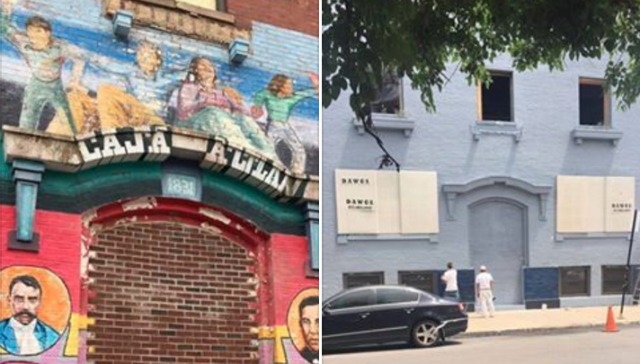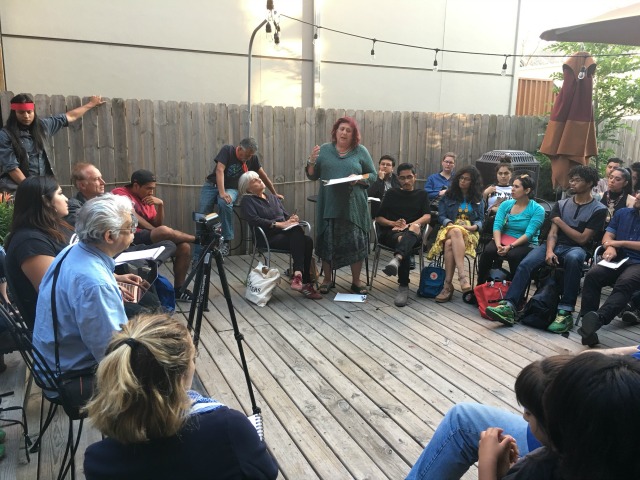Developer Aims To Replace Wiped-Out Pilsen Mural, As Community Insists 'It's About More'
By Stephen Gossett in News on Jun 28, 2017 2:11PM

Facebook / Pilsen Neighborhood, Ricardo Gamboa
The developer who erased the iconic artwork at the former Casa Aztlan space in Pilsen will recreate new murals. But even as plans are in motion to restore the key visual marker of the neighborhood’s heritage, community members on Tuesday night gathered to also address what they see as the underlying issues at heart: gentrification and displacement.
Andrew Ahitow, the Chicago-based developer of the property (1831 S. Racine Ave.) and founder of City Pads and Chicago Apartment Finders, did not appear at the packed meeting, at La Catrina Café. But Byron Sigcho, Executive Director of Pilsen Alliance, delivered a statement to the standing-room-only crowd, sent from Ahitow—who is in contact with the original muralist, Ray Patlan.
Ahitow said, via Sigcho: “We are waiting on a proposal from Ray Patlan to put a team together to re-recreate murals on the property. We hope to engage Ray and start the murals in the next 60 days.”

Photo: Stephen Gossett
“It doesn’t matter who’s there now,” Patlan told the crowd. “It’s important to landmark our presence in our community, no matter who’s there.”
Patlan said he plans to visit Chicago within two weeks to hash out plans for the mural in further detail.
But beyond the mural, activists are calling for the development to include at least 21 percent affordable housing. Ahitow reportedly says that since the property was not rezoned, that figure—a higher-than-norm, Pilsen-specific mandate—does not apply. Sigcho insists that, per the 2006 Quality of Life Plan, that’s not the case. Chicagoist has reached out to Ahitow for comment and Ald. Daniel Solis and will update if we hear back.
Sigcho also stressed a need for a community center, like the old Casa Aztlan, citing the overflow crowd itself as evidence. “The community is struggling to find spaces… There are TIF resources, there’s public funding. We need infrastructure,” Sigcho told Chicagoist. “We need the city not only to celebrate culture but allow us to have the infrastructure to do so.”

Photo: Stephen Gossett
Speaking to some of those broader concerns, groups broke off to discuss three root, underlying issues exposed by the mural controversy: housing (including the possibility of launching limited equity housing co-ops), legislative accountability, and art preservation and support. City initiatives that preserve art that already exists are vital, but so too are ones that initiate new projects, created by artists within the community, said Robert Valadaz, a Pilsen native and muralist who years ago used the original Casa Aztlan for studio space. DIY spaces and support remains a key component, too, said artist Amara Martin.
Noted muralist Hector Duarte also spoke about the deep historical and cultural significance of the former Casa Aztlan building, which was a Hull House settlement before it became a community center that served Pilsen’s Mexican residents.
The mural that adorned Casa Aztlan—which key figures such as Rudy Lozano, Frida Kahlo and Che Guevara—was painted back in 1971 by under the tutelage of Patlan. The center became a focal point of the city's emergent Chicano movement. The mural was painted over by crews working on the apartment conversion last Monday.